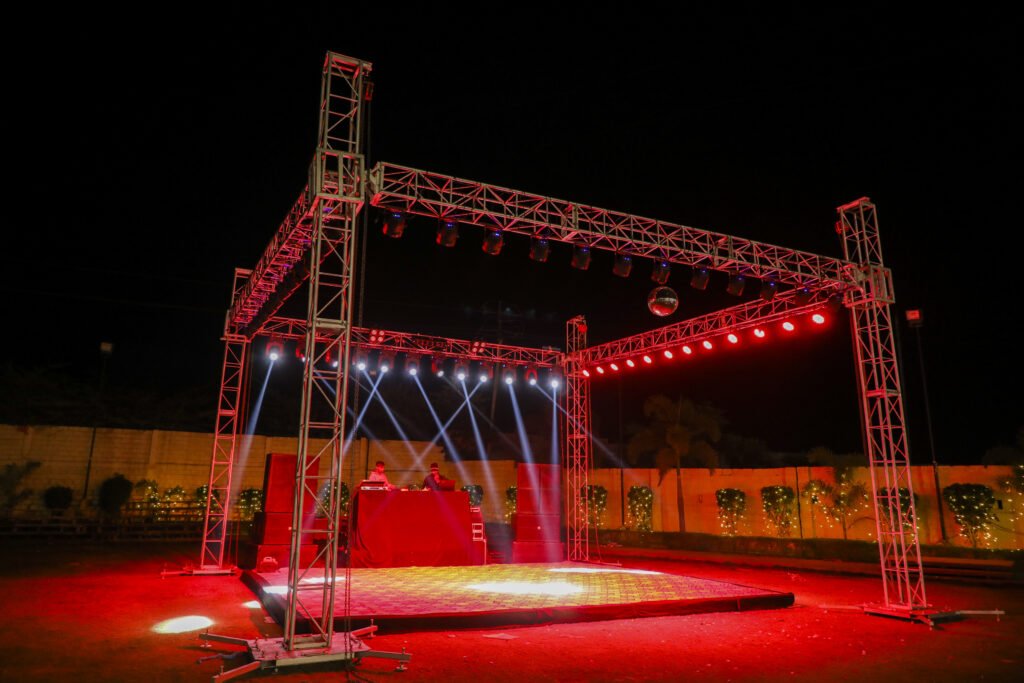Stage and lighting is awe-inspiring when done right which is why we delve into the when and where of stage lighting across Australia. Over the last few years, close club work in Melbourne laneway venues to the grand production of stage and lighting in Sydney’s large concert halls, slowly turned into the art of top tier performance masterwork. So if you would like to learn more about concert lighting fundamentals, and how you can benefit from them —whether you are a venue owner, a lighting tech, or a performer yourself, keep reading this guide!
How Stage and Lighting Works: The Basics
The primary functions of stage lighting are to light the performers, create a mood, and add to the aesthetics of the performance. Whether it’s working in one of Australia’s many city theaters or at one of our regional community halls, these are essential basics that, once mastered, translate to quality lighting design that you can take into any of the Australian performance spaces.
Lighting fixtures are the basic components to any stage set up. For smaller venues, a small arsenal of LED par cans, profile spots, and wash lights will provide a versatile foundation. For big productions, you might see moving heads, beam fixtures and complex pixel-mapping systems to create dynamic visual displays.

Having color to set the mood and compliment the performance. The emergence of LED technology has opened up a huge palette of design options for the lighting designer. Cool blues and purples lend a sense of mystery or melancholy; the warm reds and oranges can inspire energy and passion. Lighting designers in Australia are also inspired by the land, using earthy tones and vibrant colors to replicate the Australian outback or Great Barrier Reef.
Creating Depth and Dimension
Creating a sense of depth on a 2D stage is one of the problems in stage and lighting. This theme is especially appropriate in the wide variety of venues across Australia, from heritage spaces to contemporary multipurpose venues. The best way to do so is to layer the lights at distinct heights and angles in order to create depth and excitement to the overall ambience.
Backlighting can be your best friend when separating performers from the background, creating silhouettes, and providing depth on the stage. In outdoor festivals, popular throughout the Australian summer months, backlighting can be especially effective against the backdrop of a sunset or starry night sky.
Here, gobos (stencils placed in front of lights that put patterns on the wall) are used to add texture to the lighting design. Gobos can add great visual interest for your clients, and can range from simple geometric shapes (like dots, lines, or tears), to elaborate logos or designs. Iconic Australian symbols or indigenous art motifs are often recreated as custom gobos by many Australian lighting professionals to nurture an Australian context.
The Rise of LED Technology
Recently the industry has been turned upside down with LED lighting providing a range of advantages over its previous incandescent counterparts. LEDs are more power efficient, produce less IR heat and offer greater flexibility in color mixing. This is especially useful in Australia, with growing energy efficiency and outdoor venues often experiencing high heat.
LED fixtures also make it simple to change colors quickly, eliminating the requirements for physical color gels, making lighting simpler and allowing for more dynamic designs. Due to their versatility and long-term cost effectiveness, a number of Australian venues are switching over to LED systems.
Control and Programming of Lighting
Lighting Console: A lighting console is the command center of any lighting setup. Modern consoles are capable computers for designers full of cues and effects. For smaller venues in Australia compact, feature-rich consoles are favoured, as they provide access to professional-styled control in a more compact layout.
Pre-programming lighting cues can go a long way toward making a performance better. You can help audience immersion by coordinating lighting transitions with musical cues, or with stage or theatrical moments. So many Australian lighting designers also collaborate with performers during rehearsals to finesse these cues for a seamless merging of light and sound.
Atmospheric Effects
Haze and smoke machines are a powerful lighting designer tool, illuminating the light beam and helping to create an atmosphere on stage. But you have to use these effects wisely and don’t cross of the laws to do it. Australia already has a high level of bushfire awareness, with many venues operating strict atmospheric effects policies.
Safety and Practicality

Safety must always come first in stage hire services. All equipment should be appropriately secured and rated for theatrical use. It is relevant to mention that electrical safety standards apply throughout Australia, and there are also regular checks to ensure that all equipment is in a good state.
Cable management is also a consideration in stage lighting. While good cable management looks cleaner and more professional, it also reduces the chance of a tripping hazard and promotes a working performance. In the same vein, outdoor venues in Australia need to prepare for the ever-changing elements by weatherproofing lighting gear as well.
Conclusion
The craft of stage lighting is never-ending and is a balance of artistry and technical know-how. Whether lighting a small club in Brisbane or a large festival in Perth, the same principles of sound lighting design apply. With an understanding of the basics, an embrace of new technology, and a commitment to safety, the results can be stunning visual experiences audiences across the length and breadth of Australia will love.
Good stage lighting always adds to the performance rather than subtracting from it — a golden rule of talent books. More than that, to set up a coherent atmosphere of sound, light, sound and performance, with the goal of taking the audience to a different place that resonates with them and sticks. With a little trial, with a dash of the Aussie spirit of ingenuity, you can turn any stage into a canvas of light — poised to bring performances to life in stunning fashion.

